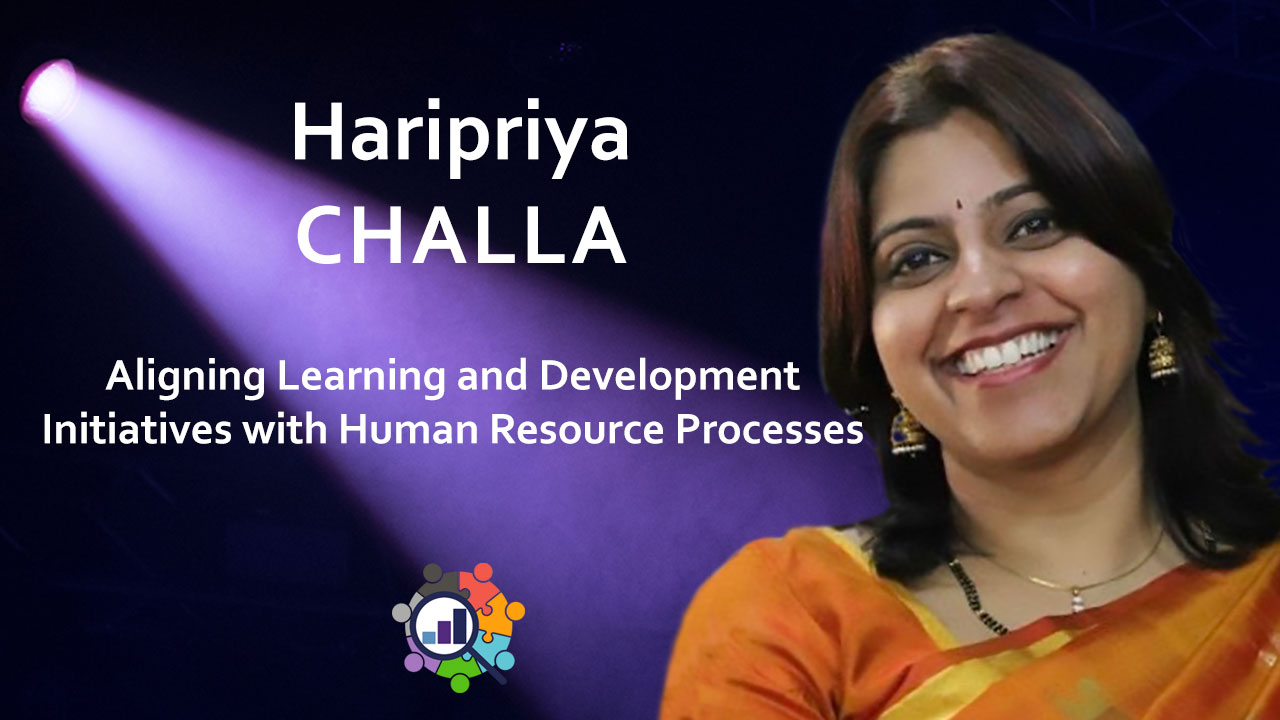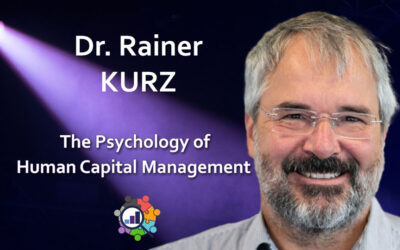A CykoMetrix Spotlight Production
Every week, the Spotlight shines on an amazing professional with a story to tell and lessons to teach. Welcome to the CykoMetrix Spotlight.
The following is an adapted transcript of the exchange between Sylvain Rochon, CMO at CykoMetrix as host, and Haripriya Challa, Director in Social Media at International Coaching Federation, Hyderabad Chapter (https://www.linkedin.com/company/icf-hyderabad-chapter)
Sylvain Rochon: Hello. Welcome to Psychometric Spotlight. I’m Sylvain Rochon, chief marketing officer at CykoMetrix, a SaaS-based service that assesses individuals, does psychometric measurements over time and benchmarks so that you can track how people are changing as effective team members, then apply training and measure again. You can then see how impactful your training was in between and continue measuring and training and developing over time for years and years and years; creating better teams, better people, better soft skills, better emotional intelligence and so on. That’s what we are excited about. Today we’re about to talk about something a little bit more specific because we have a wonderful guest in the Spotlight, Haripriya Challa.
She is the director in social media at International Coaching Federation in Hyderabad. She is a people development practitioner and a human resource strategist, partnering with multiple business leaders to implement human resource, learning and development initiatives for talent management and development which includes a leadership and behavioral coaching. My favorite: behavioral coaching. Haripriya, nice of you to be here today.
Haripriya Challa: Thank you so much, Sylvain. Thank you for setting this up. Yes, it’s an interesting space, behavioral coaching as we were just talking about.
Sylvain: For people listening, we always talk prior to the recording. We were talking about learning management and how it is applied in human resource departments, in processes, and how some businesses don’t even consider it. HR is basically ignoring that whole aspect. So, we wanted to talk about that today because this is Haripriya’s expertise. So, let’s continue the conversation because that’s a good enough starting point. Tell us about this gap that you’ve perceived, and we’ll go from there.
Haripriya: Way interesting. I’ve learned it the hard way I must say. I think the key point is understanding business, of having that business acumen. How many of us have business acumen? I mean, I started in HR, and I didn’t have the business acumen at a very, very high level. So that’s when I realized… I was always on the other side; management doesn’t approve this, management doesn’t give this, there’s no budget. I don’t get approval for this or there is high attrition, there is no salary increment or growth paths, so on and so forth. What I’ve realized is to what extent business is looking at all of these and how well are we, as HR articulating it to the business. I was caught in such a situation, and that’s when I realized how important it is to understand business, to cascade those goals across all levels and align HR strategy to the business strategy. So, that’s where my journey started, and it became quite interesting. Also, during this time, we were talking about HR generalists or HR profiles, but then it was evolving. HR business partnering was evolving, but then that’s where we really need to understand business, number one. Second thing is to cascade those business goals. Number three is all about how you communicate with your employees and get that connection with your employees.
During this process, we all have experienced a lot of policies and processes. We were so caught up with all of this, but then there was a time where employees needed to talk, to share, probably about their individual development plan. That’s what we talked about, but there was not really anything happening there. That was a space where I identified a lot of gaps within HR. Whenever I used to go and talk to my people, everybody used to keep quiet. No conversation is going on so there’s no trust built. So, I used to tell them I’m also just like any other human being, just like any other employee here. So, yes, I’ve learned the hard way. That’s a very interesting area which I’ve picked up over the last seven years now. I’ve been doing a lot of research on that and I must have trained many, about 2000 HR professionals, on understanding business and how well are they are going to partner with businesses.
Sylvain: So, this is the concept and that’s what we were talking about— where the gap is. But for the listeners can you describe, without naming names because names are not necessary, can you describe a case, either from your own personal experience— you said you’ve learned it the hard way— or from your work with the Chapter, the Federation where the gap was obvious? What was the reaction from management, what was a reaction from HR, and how your intervention or your team’s intervention changed things? Can you give us a bit of a typical, gap-filling type of engagement to illustrate this point?
Haripriya: Right. Like I said, I’ve learned it the hard way. There was a situation back in 2011. We were getting into a merger and acquisition with a Japanese and a Korean company. We had a lot of leadership interventions. We were talking about technology integration. We were talking about investments. We were talking about partnering. We were talking about research and development. We were talking about communication. All of this put together. There was a threat felt by the employees of what if we were going to lose our jobs. As an HR business partner – I call myself as a business partner now – but that time I was just a manager, senior manager of Human Resources handling people’s process and performance and tasks, and all of that.
Sylvain: So, you were a manager of HR at the company that was getting acquired or getting merged with the Japanese or Korean company?
Haripriya: More like getting merged. The fear of losing a job is quite scary and I wasn’t convinced myself. “Oh, you guys are doing it for the sake of money.” Or “You guys are letting us lose the jobs.” Do you know what I mean? So that was the situation where a lot of our employees were a little panicked. They don’t talk much, and I was not convinced myself. And that is when I happened to sit with my CEO as well as the managing director and I kind of had the luxury to have a conversation with this gentleman. I had a conversation and I said this is what everyone is experiencing. What is in it for us? Kind enough, he explained the whole strategy of why this merger is going to happen, how it’s going to impact our organization, and how is it going to elevate our roles, how is it going to empower us, and how it is going to help us increase the positioning in the market as far as brand is concerned. We all, in fact I, didn’t understand all of that. That is when I understood. I had that “aha” moment as we call them. “Ah, now I know what you’re saying.” That is when I got a little confidence, and I was empowered. I said, ‘Now I know why we are doing certain things, why business doesn’t say yes or no to certain things.” That is when I understood. I channeled my thoughts and with the help of other business leaders, I could cascade this information across to the employees and it went really well, number one. The second thing is that after understanding what the business looks at, what business wants from the HR department, it was easy for me to collaborate with other business units. So, it was quite easy for me. Of course, I had to learn some technical terms from other business units.
Sylvain: You’re right. From our experience working with companies, a lot of them are in HR. Our clients are not typically HR staff, just to be clear. Our clients are consultants. They deal with HR. So, we have these triads of conversations because they have their clients, and we are helping our resellers essentially help the HR department. What we found is that HR is very often separated from the business piece of things. Like you said, they are administrative. They deal with the contracts of the employees, the onboarding, the sick leave, all these things and benefits, all the administrative bureaucratic elements of Human Resources. One of the things that came out in discussions about this is there doesn’t seem to be a lot of “human” in Human Resources in some of the companies because it only deals with the paperwork, not the person much. Knowing the business, having that understanding of the business, how you translate it, like in a consulting way or in a teaching way, to businesses that are set up with administrative HR departments like you are seeing them. Well, okay, you need to do something a bit different to get the outcomes they need. How do you interface with the executives and with the HR teams to teach them the importance of the human aspect of HR?
Haripriya: I usually have a story to tell in my training programs for HR business partnering: somebody went and asked one of the janitors at NASA, “What do you do?” The person expected the typical response. “I keep the place clean, or I maintain hygiene.” But then this janitor responded, “I support my astronaut landing on the moon.” That’s the vision that should get cascaded and penetrated across the organization across to the employees. So, that’s the story I keep telling. Even if it’s an administrative task, it’s important. And how well are you projecting it? How well are you using the data analytics, and then sharing it with people? When I say data analytics, it doesn’t have to be humongous data set that the analysts use, but whatever information that you work with, see if there is a trend, see if there is any change in the way things are moving, or if there is anything happening. And then, put on your critical thinking hat and see if you can call something out, and see if there is a need for you to have a conversation with that person or with that team. Yes, because a lot of times what happens is people do come back to the session stating that HR is all about strategy. “I am into recruitment.” Or “I’m doing basic admin jobs, handling these policies and updating the trackers and all of that.” Yes, put on your critical thinking hat, put on your analytical thinking, and ensure that whatever you do, observe the trends. Is there a story coming across? See if you can highlight that so that you know what you are doing and why you’re doing it. Did I make sense?
Sylvain: Yes, that does make sense. In some of the cases on our end, what we discover surrounding this very discussion is that HR is mishandling things like turnover and hiring. The turnover rates are a real business concern. It’s costly, right?
Haripriya: Yes.
Sylvain: I’m not teaching you anything, but that’s one of the big things that I keep hearing about. It’s a lot about the hiring. Why do people leave? Then we need to hire more and there are costs to that. That’s a business concern and that is something that’s handled by HR. Primarily, it’s hiring and trying to keep the employees. So, what tools do you lay out or do you suggest to the practitioners or your learners and the businesses that’ll help them have visibility over those very real business concerns and what to target? What should you train? What kind of development process should be applied? Who should you hire? Sometimes it just as basic as to avoid the turnover concern. What are the tools and services that you promote or recommend?
Haripriya: All right. So, I would divide my response into two categories. One is at the business level, and one is at the technology level. Coincidentally, today I was just talking to a set of HRs for a very big e-commerce giant. We were talking about attrition analysis. Is it absconding? Is it absenteeism? Is it lack of interest? We thought of a series of reasons. We kind of categorized a whole lot of reasons as to why there’s so much attrition happening. We identified a lot of it and then once we understood it, okay, now we go back to the cost element. So, level 1 employees are quitting, what is the percentage of each level, and at what cost? Is it okay for the company to bear costs at that level? When you really talk about the business, certain times attrition is acceptable in the organization and the cost that we are investing. I hope I made sense here. Yes. Is it natural? Is it functional, or dysfunctional? Controllable? Uncontrollable? You keep track of that. Now then, if it is uncontrollable, then you will need to address that. Is it aligning with the culture? Is it impacting your culture? Is it impacting the brand? So, that is one element that we all need to look at when we do the analytics here, and on the other side of the technology element. Every attrition, every behavioral change needs to be observed. At the time of recruitment, I would definitely recommend people do behavioral tests before doing the interview, number one. The second thing is, do a bit of psychometry. Be it with the personality style or depending on what competencies you are recruiting them for, maybe some ability tests depending. I think the interview process has to be stringent. Now, the question is, do we have that much time with the kind of demand that we have?
Sylvain: Well, yes, because even in my space which is the psychometry part, the assessment piece, one of the concerns are the gaps we’re attempting to fill. We’re successful at the time aspect. Like, how much time do you want to spend or resources, like money or whatever, after doing the test? How much value do you derive from that? Our whole system is designed to fill that gap, to make it easy. Assessments are half an hour, and the reports are immediate for the team. The HR can immediately see, using just a few numbers, what that person going to be like in that team, and things like that. But it’s still something additional. The human resource team must have motivation to use and see value in using these. Otherwise, since they’re not the bean counters they may just say, “No, I’m not going to use that because it’s one additional thing in my job”. Right? So, we tend to encourage our clients, “Don’t talk to the HR department so much. Talk to the businesspeople. Talk to the CEO. Show them the money.”
Haripriya: Yes.
Sylvain: Yeah. And then, they can educate or force their HR departments to do something different. And then if they can see the value from it in their own work, like they have to hire less, well, that’s less work. Right? If they have an easier training program, they can latch onto taking in less work for themselves. Because then they know what to train each team. The assessments would provide that information. That’s the gap we filled to help out in the space. But you’re right, it’s a challenge. These are all important pieces into the business decision.
Haripriya: On the same lines, what we have also done is ensuring that the recruitment team, the talent acquisition team is quite aware and sensitized about the importance of psychometric tests. Because most of the time, I think a lot of people feel that it’s a game changer. It’s an elimination. Yes, to an extent, but then you really have to deep dive and see what exactly, what competencies are you looking for and which tests are you doing. Which competency are you assessing, that’s one. The second thing is we should be able to read those reports in a manner that the profile is resonating and check for fit. It is so, with a couple of training programs for recruiters as well as understanding various psychometric assessment. So, that’s another important element that we might want to bring in that becomes quite common.
Sylvain: I think I’ve heard a lot about that, too, in our conversations. There are a lot of psychometric assessments out there. They are, from what I heard from a lot of interviewees, often misused. They’re like, “Let’s do psychometry test.” They do them and then they don’t do anything with the results. It just kind of a fun afternoon with the team and that’s it. But there’s actual value in it and some assessments are better than others. Some are better for certain companies than others, depending on what they’re trying to achieve, what they’re trying to measure. So, there seems to be a gap for consultants, trainers, staffing agencies to fill, just in how to use the available assessments out there effectively to achieve real business objectives and get real business changes. That’s where the International Coaching Federation can go. You teach them the importance and how to use the tools. Is that correct?
Haripriya: I see we do a lot of coaching, then after tests if required.
Sylvain: Yes. You do the actual coaching?
Haripriya: We do the coaching here. But yes, these psychometric tests could be done at various levels.
Sylvain: That’s cool.
Haripriya: I think the International Coaching Federation focuses on coaching based on the results that we might get, and it depends on different coaches whether they want to do X Y, or Z or MBTI or 360 degrees. It depends on what kind of coaching that they’re doing. Yes.
Sylvain: So, to finish off, we may have hopped over this, but I think it is important for the audience to define who is the International Coaching Federation, because we didn’t really talk about that specifically. Can you describe the Federation? I know you’re the director of social media in the Hyderabad Chapter. So, this is a bigger organization. Can you describe it as well as what it does?
Haripriya: So, International Coaching Federation is based on community services where we do a lot of coaching across levels, across organizations, across genders, ages. So, it’s basically a self-development process. It’s a conversation where a lot of trust is built between the coach and the coachee (client). It’s more of a development process, like I said. It’s confidential. For example, you and I are talking, and I want to develop further. Yes, I will talk to you. Me being your coach, I would ask you those questions which make you think through what best you can bring about yourself, unleashing your own potential. That is what we do. This is a global organization headquartered in the United States and we have a chapter in India. Hyderabad is one of the chapters. We formed last year. We have a team of 60 coaches now in the chapter. Yes, we do coach people, and we are trying to increase our reach to people at various levels.
Sylvain: In this case it’s Hyderabad but do you have a membership? Like, people like coaches and trainers who are part of other companies, for example, or self-employed as members? They can join the chapter to tap into its resources basically and learn?
Haripriya: Absolutely.
Sylvain: Okay. So, if anybody out there is a coach in Hyderabad or trainer, that wants to access some great resources, you can just contact the International Coaching Federation and Haripriya. They may be able to help you out, I suspect, to enhance and improve your own business, private practice, or dynamics inside your own company. I think that’s really cool. There are many organizations like this in different domains. I was not aware of such an international organization. New discoveries every day. If you would like to tell the audience something just to leave off and to end this talk, what message do you want to share to finish off here?
Haripriya: That’s a huge one.
Sylvain: Yeah, I know.
Haripriya: Yes. I think I would probably preach what I practice. I mean, I might want to share what I’m currently practicing. I think self-awareness is the key for your own enhancement, and self-development. Identifying my own blind spots in various capacities is the beautiful journey that I’m experiencing right now. So yeah, if that resonates with anyone.
Sylvain: I think that’s great. It is very generic. It applies to everything and that’s why it’s important. Being self-aware means, hopefully, you’ll grasp onto more opportunities to learn and improve, and develop oneself.
Haripriya: Yes. Absolutely.
Sylvain: So, I think self-awareness. That’s the starting point. That’s great. Thank you so much, Haripriya for spending this time with me this morning in the Spotlight. Keep doing what you’re doing. It’s great. I love it.
Haripriya: Thank you, Sylvain. Thank you so much.
About Haripriya Challa – www.linkedin.com/in/haripriyachalla
Haripriya is a people development practitioner and an HR strategist partnering with multiple business leaders to implement HR and L&D initiatives for Talent Management and development, which include Leadership and behavioral coaching.
Haripriya is full of energy and enthusiasm, which is contagious.
Her communication and listening skills help her clients experience effective and engaging conversations. She helps one believe in their strengths and works with people around her to be one’s better self.
Her situational adaptability, cross-cultural sensitivity and persuasiveness help her drive business and HR deliverables. she enjoys working with people to create human happiness.
About CykoMetrix – www.CykoMetrix.com
CykoMetrix is a leading edge combinatorial psychometric and human data analytics company that brings the employee assessment industry to the cloud, with instant assessments, in-depth analysis, trait measurements, and team-based reporting features that simplify informed decision-making around recruiting, training, and managing today’s modern workplace.



